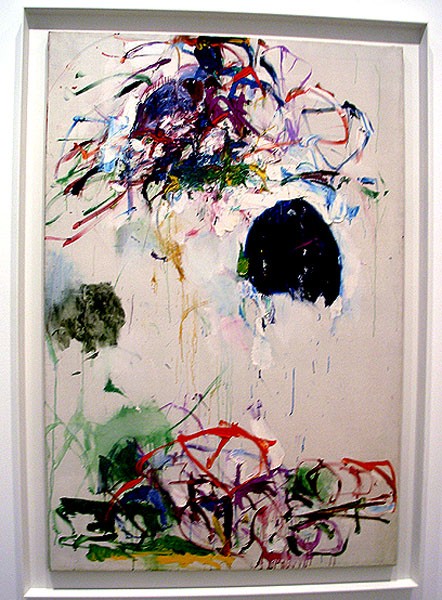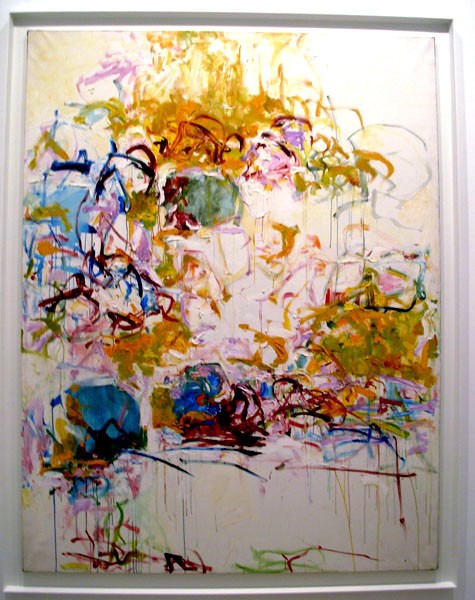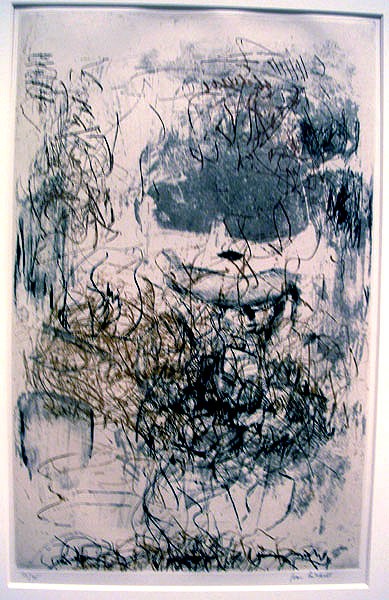Joan Mitchell: Sunflowers
Cheim & Read Gallery, Chelsea
By: Charles Giuliano - Dec 22, 2008
Joan Mitchell Sunflowers
Cheim & Read
547 West 25th Street
New York, New York
212 242 7727
November 6 through December 20
http://www.cheimread.com/
The recent exhibition at Cheim & Read Gallery in Chelsea "Joan Mitchell: Sunflowers" with works from the 1960s through her last year (February 12, 1925- October 30, 1992) affirms that she belongs on the short list of the greatest abstract painters of her generation. The exhibition included single paintings, the late diptychs, drawings, and etchings. While the reviews in the Wall Street Journal and New York Times describe the exhibition as uneven perhaps they miss the point. This was a posthumous installation so it is more accurately described as a selection of inventory than a scholarly inquiry into her remarkable achievement.
Perhaps this is not the occasion for an evaluation of her career as these remarks are based on a small and narrow selection of the oeuvre. But during a recent tour of Chelsea galleries this experience was notable for its fresh, vibrant, vitality. One reveled in the presence of an artist with unique vision and personality.
When surveying exhibitions, catalogues, and critical studies of the era of the Abstract Expressionists, given all the ambiguities in that quixotic term, it is never difficult to pick out and identify the hand, look, and touch of a Mitchell painting. In all the daubs, slurs, drips and slashes of that era there is her singular touch. It is the more remarkable for having seemingly little to conflate with the iconic works of that time and place. While she clearly imbibed of the same well of inspiration Mitchell also was independent in seeking her own muse.
Regarding her career and personal development the fact that she opted to spend much of it in France had an enormous impact. She moved to Paris in 1959 snd settled in Vetheuil, 40 miles from Paris on the Seine, in 1968. It may not have been a wise career move, as a second generation abstract expressionist, to be out of New York during a time when the influence of that approach was waning and pushed aside by new forms of art making. It also liberated her from the strong grasp of the New York School and opened her to European sources. The Sunflower series, for example, has been discussed within the context of van Gogh, her landscapes have been compared to Cezanne, and in the last diptychs on view at Cheim & Read, one feels the presence of the epic, late water lilies of Monet. They were created when the artist, suffering from cataracts that left him all but blind, was at his most abstract. Clement Greenberg wrote about late Monet in the context of anticipating aspects of all over painting.
What one most strongly feels in the work of Mitchell is a combination of scratchy, frenetic mark making (most evident in the etchings) and the clarity of her palette. The color always feels controlled and deliberate. There is a compelling logic and reason for a particular use of red, yellow, earth tones, and blue. The colors and strokes are evocative of references to nature or perhaps just poetic tone and mood. Most consistently there is a lot of white, unpainted canvas.There is a similar sensibility in the paintings of another American who lived abroad, Cy Twombly. In that aspect the works feel more like drawings on canvas than finished paintings. There is a sense of time. The paintings represent actions or choreography of the hand and the swing of an arm and shoulder. The resultant surface comes from a ritual dance derived from Automatic Surrealism. Of course she shares that with Pollock the foremost artist/dancer of his time. Pollock also used the primed white ground of his canvases as a part of their aesthetic and pictorial space.
Leaving that air in the work in terms of white as ground/ color also evokes a norm for water color. Using thin, transparent paint the white of the support is allowed to breathe through and often employed as an element of chiaroscuro. This was first explored by the Impressionists who deviated from the tradition of painting a thin tone of ochre or umber to mute the glaring and distracting reflection of the gessoed surface. Artists then work in and out of a mid range of chroma and value to achieve chiaroscuro. The Impressionists felt that this use of underpainting dulled the intensity of their color which led to the process of color assimilation and allowing the scumbling to occur in the eye and not by dragging colors on the canvas. The process of abandoning toned grounds was regarded by Greenberg as liberation from the use of illusion in the picture plane and the triumph of flatness.
So the remarkable late paintings on view at Cheim & Read are, well, very French. The immediate feeling of seeing them was that they channeled late Monet. They are called Sunflowers and may be regarded as a series of blooms in a field, but of curiously non local color.
Of course the artist is not here to discuss or debate these observations. The work remains and evokes a dialogue. It is interesting that by leaving New York for such a long time she was not a part of the aesthetic and critical turmoil of the movements she is associated with. So her return to primacy in New York galleries and museums is something of a rediscovery. We approach Mitchell's work on its own terms and that, my friends, is quite wonderful.











